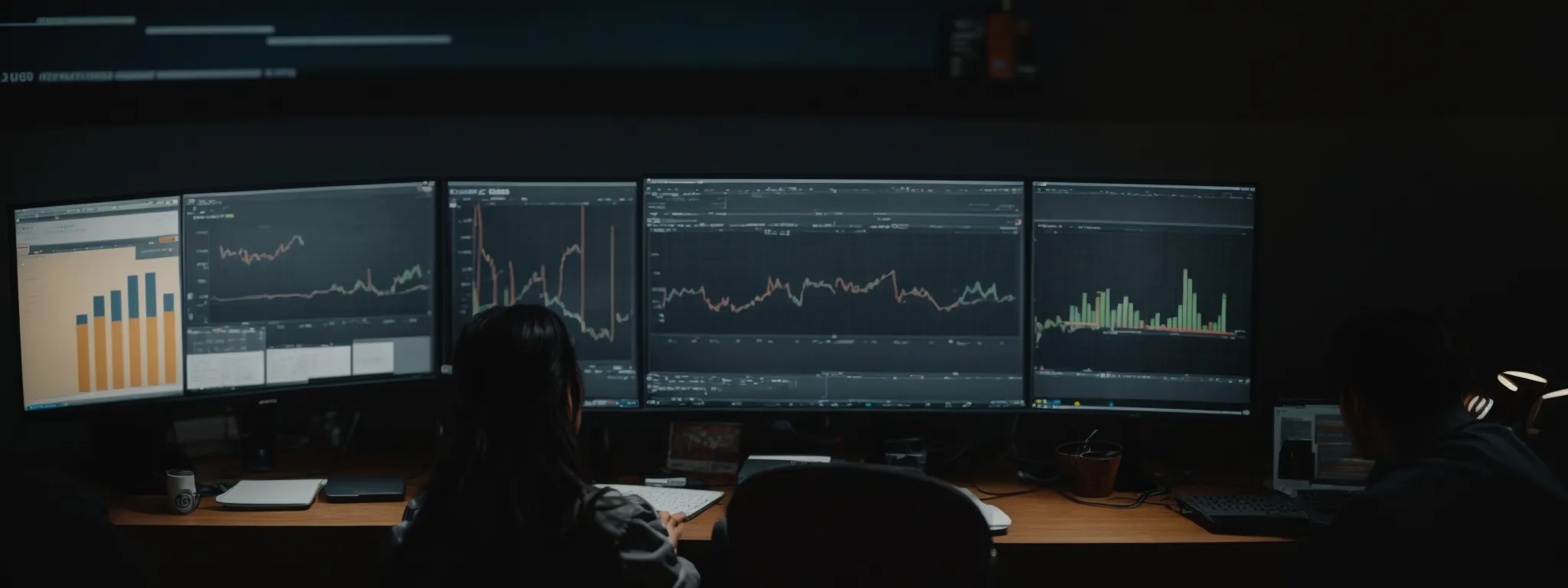Master the Technical SEO Checklist
Complete Your Guide to Mastering the Technical SEO Checklist In the dynamic field of digital marketing, Technical SEO stands as the robust foundation that supports a website’s […]
Complete Your Guide to Mastering the Technical SEO Checklist
In the dynamic field of digital marketing, Technical SEO stands as the robust foundation that supports a website’s visibility and searchability.
Delving into technical SEO requires a vigilant eye for detail and a clear understanding of how search engines crawl and index web pages.
With LinkGraph’s comprehensive guide, businesses can navigate the intricacies of site audits, HTTPS security, and mobile optimization, ensuring their digital presence is built on a rock-solid foundation.
This article serves as a beacon for those striving to ensure their website architecture perfectly aligns with the demanding criteria set by search engines.
Keep reading to unlock the full potential of your website through proven technical SEO practices.
Key Takeaways
- Technical SEO Is Critical for Website Visibility and Ranking Capabilities
- LinkGraph Employs Rigorous Technical SEO Practices, Including Site Speed Optimization and Structured Data Implementation
- Regular Technical SEO Maintenance and Updates Are Essential for Staying Competitive in Search Engine Rankings
- Mobile-Friendliness Is a Fundamental Aspect of Technical SEO in Today’s Mobile-First Digital Landscape
- Advanced Technical Strategies Like Implementing AMP and PWAs Can Significantly Enhance User Experience and SEO Performance
Understanding the Essentials of Technical SEO

Within the labyrinthine world of digital marketing, technical SEO forms the bedrock that supports a website’s visibility and ranking capabilities.
It is a critical puzzle piece, often overlooked, that functions behind the scenes to ensure a seamless user experience and a favorable evaluation from search engine algorithms.
As industry professionals peel back the layers of their SEO strategies, two critical areas stand in focus: grasping the vital role technical SEO plays in securing coveted rankings and identifying its core components to guide their optimization efforts.
The efficacy of mastering these technical intricacies not only bolsters a site’s ability to climb SERPs but unlocks potential for considerable growth in organic search traffic.
Grasping the Role of Technical SEO in Rankings
The ascendancy of a website within search engine result pages hinges profoundly on technical SEO, a component often enshrouded in obscurity yet paramount to success. Through meticulous attention to elements like site architecture, crawler accessibility, and mobile responsiveness, businesses set a Concrete Foundation for Higher Rankings.
LinkGraph’s approach to technical SEO emphasizes the significance of pristine, navigable site structure to bolster search engine appraisal. Embedding the appropriate schema markup, optimizing URL structure, and ensuring swift load times are orchestrated with precision to enhance visibility:
| Technical SEO Element | Purpose | LinkGraph’s Best Practices |
|---|---|---|
| Site Architecture | Facilitates user navigation and search engine crawling | Logical hierarchy, clean navigation menus |
| Crawler Accessibility | Allows search engines to index content effectively | Optimized robots.txt, streamlined indexing directives |
| Mobile Responsiveness | Ensures usability across devices | Responsive design, mobile-friendly testing |
| Site Speed | Contributes to positive user experience | Page speed optimization, server performance assessment |
| URL Structure | Improves readability for users and search engines | Descriptive URLs, consistent use of hyphens and low-case letters |
Identifying the Core Components of Technical SEO
To navigate the complexities of technical SEO, identifying its core components is imperative. LinkGraph offers services that scrutinize every angle of this intricate landscape, ensuring elements like SSL certificates and canonical tags function harmoniously, which solidifies site security and avoids duplicate content issues respectively, fostering trust with both users and search engine algorithms.
LinkGraph’s Meticulous Analysis extends to XML sitemaps and site audit tools, which are pivotal in cataloguing a site’s content for search bots, while providing comprehensive insight into areas ripe for optimization. This level of detailed assessment is crucial for enhancing a website’s search visibility and maintaining an edge in the ever-competitive digital realm.
Initiating Your Technical SEO Audit

Embarking on a technical SEO audit is a strategic step toward deciphering the complexities that affect a website’s search engine standings, involving a multilayered examination of a website’s structure and performance.
Equipped with specialized tools and a Structured Workflow, professionals at LinkGraph meticulously dissect every component of a website’s technical health.
This process involves rigorously testing for issues that might impede its search engine visibility and ensuring that all SEO tenets are not just met but surpassed.
The technical audit serves as a linchpin, orienting businesses towards the pursuit of digital excellence and Superior User Experience, ultimately leading to a vaunted position within the search engine result pages (SERPs).
Tools You Need to Start a Technical Audit
Embarking on a technical SEO audit necessitates sophisticated tools tailored to dissect and scrutinize a website’s framework. LinkGraph’s suite, including its proprietary SearchAtlas SEO software, provides a robust foundation for in-depth site analysis, identifying vital technical discrepancies that hinder online prominence and informing strategic enhancements.
Inclusive in the toolkit essential for a thorough technical audit is LinkGraph’s Free SEO Audit Tool, which delivers a snapshot of a website’s SEO health, pinpointing areas of improvement from meta tags to site speed. Such a comprehensive scan empowers businesses to make data-driven decisions that could significantly boost their digital footprint.
Setting Up a Structured Workflow for Audits
When embarking on a technical SEO audit, professional SEO practitioners prioritize the creation of a structured workflow that delineates each phase of the process. At LinkGraph, this includes segmenting tasks into manageable chunks that cover all technical aspects, such as indexing, site speed, and mobile compatibility, to name a few.
A well-organized workflow ensures systematic coverage of all essential SEO elements, facilitating a comprehensive examination that leaves no stone unturned. LinkGraph’s tailored workflow facilitates the accurate identification of technical gaps and the efficient deployment of optimization techniques, ultimately driving robust search engine rankings for clients.
Mastering on-Page Technical SEO Factors

Amid the quest for digital supremacy, brands are increasingly cognizant of the profound impact that on-page technical SEO elements wield on their online success.
Meticulous optimization of URL structures and a diligent refinement of site architecture are seen as instrumental steps towards bolstering a website’s indexing potential.
Sharpening these vital facets enables corporations to excel in both user engagement and search engine rankings, ultimately becoming linchpins in the grand mechanism of online discoverability.
Optimizing Your URLs for Maximum Effect
Optimization of URLs is a strategic endeavor that LinkGraph seamlessly integrates into its comprehensive SEO services. This optimization ensures that URLs are concise, free of unnecessary parameters, and imbued with targeted keywords that align with a brand’s digital identity and SEO content strategy, thus enhancing their click-through rates and search rankings.
Clear, descriptive URLs optimized by LinkGraph not only advance a site’s SEO performance but also enhance user experience. The clarity of a well-structured URL enables both users and search engines to grasp the content’s theme at a glance, contributing to a more intuitive and effective navigational structure within a website’s ecosystem.
Enhancing Site Structure for Better Indexing
A robust site structure is paramount in steering search engine algorithms to index content with greater efficiency, a cornerstone tactic LinkGraph meticulously applies in its suite of on-page SEO services. By crafting a logical hierarchy and crafting a streamlined navigation experience, LinkGraph’s strategists empower websites, allowing them to communicate their content’s relevance and quality to search engines with unprecedented clarity.
LinkGraph’s expertise extends to enhancing a site’s internal linking strategy, which systematically guides search engines through the most critical pages, thereby improving indexability. Such strategic structuring not only aids in optimal content discovery but also reinforces the thematic pillars of the website, allowing for a well-organized presentation of information to both search bots and users alike.
Ensuring Site Speed and Performance

In a digital landscape where the adage ‘time is of the essence’ takes on a literal significance, ensuring a website’s performance and speed is paramount for any SEO undertaking.
A website’s load time is a critical player in user satisfaction and a decisive factor in search engine ranking algorithms.
Consequently, technical SEO professionals concentrate on evaluating and enhancing page load times as a pivotal aspect of their optimization strategy.
Businesses eager to maintain a competitive online presence turn to LinkGraph for ensuring their site is not only responsive but also expedited, for both the boosting of their SEO and the betterment of user experience.
Analyzing Page Load Times for SEO
Analyzing page load times is a critical aspect of SEO, as delayed loading can deter visitors and increase bounce rates, thereby negatively impacting a site’s search ranking. LinkGraph’s SEO experts utilize advanced tools to assess and optimize a website’s load time, ensuring rapid content delivery and an enhanced user experience.
The outcome of such meticulous analysis leads to targeted improvements: optimizing images, minifying code, and leveraging browser caching. These measures are taken to reduce the time it takes for a website to become fully interactive, solidifying user engagement and bolstering the site’s standing in SERPs:
- Image optimization results in reduced file sizes without sacrificing quality.
- Code minification removes unnecessary characters from HTML, CSS, and JavaScript.
- Browser caching enables repeat visitors to enjoy faster load times by storing assets locally.
Implementing Solutions to Improve Speed
LinkGraph recognizes that expeditious content delivery plays a critical role in SEO and user retention. Their technical team deploys various optimization techniques, ensuring that resources are efficiently served, and server response times are minimized, leading to a more immediate display of content to the eager user.
By integrating advanced caching mechanisms and establishing optimal server configurations, LinkGraph ensures that each website they nurture resonates with the speed that modern users have come to expect. These improvements form part of a broader strategy to enhance overall website performance and secure top-tier search rankings.

Ensuring a website is fully comprehensible to search engines rests at the heart of technical SEO, a critical determinant of online visibility and success.
Challenges concerning indexability and accessibility, if left unchecked, can undermine even the most well-crafted content strategies.
Experts focus on unraveling common indexing obstacles and refining how content is presented, to guarantee that search engines can easily traverse and catalog the information offered.
Within this environment, businesses eager to excel lean on LinkGraph’s adept optimization services to address these pivotal concerns, enabling their digital assets to become more discoverable and therefore more likely to achieve prominent rankings.
Solving Common Indexing Problems
Solving common indexing problems starts with a comprehensive evaluation of how search engines interact with a website’s content. This task demands close scrutiny of the robots.txt file, which directs the crawling of site pages, ensuring it accurately permits access to valuable content while preventing search engines from indexing duplicate or irrelevant pages.
The implementation of HTTPS encryption represents another crucial measure toward resolving indexability issues. Secure protocol not only reassures visitors about the safety of their data but also satisfies search engine preferences for secure websites, thereby aiding in a smoother indexing process:
| Indexing Challenge | Diagnostic Tool | Optimal Solution by LinkGraph |
|---|---|---|
| Access barriers in robots.txt | Robots.txt Tester | Careful modification to allow search engine access |
| Lack of HTTPS encryption | Security Audit Tools | SSL Certificate Implementation |
| Duplicate Content | Site Audit Software | Canonical Tags and Content Revitalization |
As SEO specialists, professionals concur that a meticulously constructed sitemap can simplify and Expedite the Indexing Process, laying out a clear blueprint for search engines to follow. LinkGraph tailors XML sitemaps to reflect the most current and crucial pages of a website, ensuring a more complete and efficient indexing by search engines, thus propelling the site toward optimal visibility and search ranking.
Making Your Content Easily Accessible to Search Engines
LinkGraph’s commitment to making content accessible to search engines begins with the meticulous alignment of on-page elements with SEO best practices. Strategic integration of descriptive meta tags and alt attributes ensures that LinkGraph not only strengthens the relationship between content and its intended audience but also bridges the gap between the website and the search engine crawlers.
Moreover, the thorough application of schema markup exemplifies LinkGraph’s dedication to content accessibility, marking up structured data to amplify the clarity and context of the information presented to search engines. This nuanced approach feeds into the search engine’s comprehension, paving the way for content to be showcased more prominently within the search engine result pages.
Securing Your Website With HTTPS

In an era where digital security is paramount, adopting HTTPS has become an essential marker of trust and integrity on the web.
For businesses seeking to fortify their online presence, the transition to this secure version of the HTTP protocol is not only a safeguard but also a strategic SEO move.
As they embark on this journey, the synchrony between enhanced security protocols and SEO efficiencies becomes clear.
Professionals who adeptly navigate the steps to migrate to HTTPS not only shield their site from vulnerabilities but also potentially enjoy a lift in search engine rankings.
This introduction to securing your website is a prelude to understanding the methodical approach and the inherent SEO advantages that accompany a website’s transition to a secure online environment.
Steps to Migrate to HTTPS
The migration to HTTPS is a decisive step, commencing with the acquisition of a Secure Sockets Layer (SSL) certificate from a reputable authority, a task LinkGraph deftly handles to ensure a secure connection between the user’s browser and the server. Following this, LinkGraph’s specialists update all website URLs, converting them from HTTP to HTTPS to secure every data transfer that occurs on the site and cement the trust of its visitors and search engines alike.
Once the SSL certificate is in place, LinkGraph conducts a meticulous update to internal links, scripts, and tags to reflect the shift to HTTPS. This critical phase circumvents potential mixed content errors, where non-secure elements could weaken the security of a page, thus preserving user confidence and the integrity of the SEO strategy.
SEO Benefits of Securing Your Site
Securing a website with HTTPS is an important ranking signal for search engines, acknowledging a website’s commitment to user security. Websites that adopt HTTPS may experience a favorable impact on their search engine rankings, as this encryption protocol is a marker that search engines use when determining the trustworthiness and quality of a site.
The implementation of HTTPS can lead to increased user trust and higher conversion rates, as visitors are more likely to engage with a site that visibly protects their data:
- Enhanced security prompts user confidence, leading to potentially lower bounce rates and extended engagement.
- Google has explicitly recognized HTTPS as a ranking factor, incentivizing websites to prioritize this protocol.
- Encrypted connections prevent man-in-the-middle attacks, preserving the integrity of the user’s data and the website’s content.
Making Your Website Mobile-Friendly

In the quest for digital preeminence, the shift towards mobile-centric web experiences has reinforced the necessity for websites to adapt and thrive in a mobile-first world.
A core component of technical SEO, mobile-friendliness, is not an ancillary feature but a fundamental aspect determining a site’s search engine performance and user engagement.
Embracing mobile SEO strategies and ensuring mobile compatibility are imperative for businesses seeking better rankings and seeking to meet the demanding standards of today’s digital landscape.
Rigorous testing and strategic planning pave the way for seamless navigation and interaction, promising a competitive edge in the crowded digital marketspace.
Testing Your Site for Mobile Compatibility
In contemporary digital ecosystems, mobile compatibility stands as a critical litmus test for a website’s viability and user reach. It is essential to ensure that websites perform with swift responsiveness and that layouts are optimized for a variety of screen sizes, reflecting the predominant mobile usage among users today.
Professionals at LinkGraph conduct rigorous tests to evaluate mobile-friendliness, scrutinizing a website’s structural nimbleness and verifying its adaptability across different devices. These diagnostic assessments are integral to optimizing user experience and bolstering a site’s SEO performance:
| Mobile Compatibility Factor | Evaluation Metric | LinkGraph’s Optimization Criteria |
|---|---|---|
| Responsive Design | User Interface Adaptability | Fluid grids, flexible images, and media queries |
| Loading Speed | Mobile Page Load Time | Compressed assets, optimized server response time |
| Usability Elements | Navigation Ease, Link Spacing | Touchscreen-ready design, simplified menu structures |
Mobile SEO Strategies for Better Rankings
To ascend the ranks within the digital hierarchy of mobile searches, businesses must cultivate an understanding of Mobile SEO Strategies for Better Rankings. Emphasizing mobile optimization within their SEO blueprint, LinkGraph’s strategies ensure that their clients’ websites are not only discovered but also preferred by search engines on mobile platforms.
LinkGraph takes meticulous steps to enhance the mobile user experience, knowing well that optimized mobile sites lead to improved rankings and increased user engagement. Some strategies include:
- Refining mobile site design for touch navigation and minimal load time.
- Employing AMP (Accelerated Mobile Pages) to streamline content delivery on mobile devices.
- Optimizing for mobile search queries by integrating voice search and conversational keywords.
Harnessing the Power of Structured Data

Ascendancy in the search engine landscape involves not only understanding the myriad intricacies of SEO but also effectively employing the potent tool of structured data.
Businesses poised for prominence turn to schema markup and structured data to provide search engines with detailed insights into the content of their websites.
These advanced annotations empower search engines to furnish rich, informative snippets that elevate a brand’s online prominence.
Contemporary SEO practices harness these strategies as essential elements within a technical SEO checklist, aiming to refine search presence and situate websites as clear, authoritative sources in their respective realms.
Incorporating Schema Markup in Your SEO Plan
In the digital ecosystem, the strategic incorporation of schema markup is paramount for businesses aiming to enhance their SEO plan. LinkGraph’s experts advocate for the adoption of structured data, which allows search engines to parse and display content in a more user-friendly format, thereby increasing click-through rates and potentially improving SERPs positioning.
By implementing schema markup, LinkGraph helps websites signal the context of their content to search engines with greater precision:
- Identifying the most relevant schema types that align with the website’s offerings.
- Inserting the correct markup into the site’s HTML to detail the elements presented.
- Testing and validating the markup using tools to ensure accurate implementation and maximum efficacy.
Auditory refinement using schema markup is an intricate task where LinkGraph excels, carefully embedding this metadata to magnify content discoverability and enhance the user’s search experience.
Using Structured Data to Enhance Search Presence
Structuring data judiciously, LinkGraph capitalizes on the ability to clarify a website’s information for search engines, thereby elevating its visibility and authority. The deliberate application of this data magnifies the nuance and context of website content, which in turn, increases the likelihood of richer search results and a more commanding online presence.
LinkGraph’s employment of structured data is not a mere adjustment but a transformative endeavor that enriches the virtual portrayal of their clientele’s assets. This infusion of metadata empowers search engines to render enhanced snippets that succinctly capture and display the essence of the content, making it sterling and more clickable in the eyes of the searcher.
Creating an XML Sitemap and Robots.txt File

Navigating the multifaceted terrain of technical SEO requires a tactical approach to elements crucial for guiding search engines through one’s digital domain.
Sitemaps and robots.txt files serve as foundational tools within the broader technical SEO checklist, directing the attention of search engine crawlers to a site’s most valuable content, while preventing them from accessing certain sections as needed.
Understanding the importance of XML sitemaps in enhancing search engine optimization efforts, alongside the strategic formulation of robots.txt files, sets the stage for a nuanced dialogue on optimizing these resources for peak digital performance and accessibility.
The Importance of Sitemaps for SEO
The strategic implementation of XML sitemaps is pivotal, acting as a road map for search engines to efficiently find and index a website’s pages. LinkGraph ensures that sitemaps are meticulously crafted to enhance the discoverability of a company’s content, cementing its place in SERPs:
- Construction of detailed sitemaps that outline the website architecture and content priority.
- Submission of sitemaps to search engines through their respective webmaster tools to expedite the indexing process.
- Regular updates and resubmission following site changes to keep search engine information current.
A well-organized sitemap not only aids search engines in crawling efficiency but also supports the site’s ongoing SEO journey. It’s a component that reflects LinkGraph’s comprehensive understanding of technical SEO facets, aligning a website’s infrastructure with the algorithms’ need for structure and clarity.
Crafting and Implementing a Robots.txt File
Crafting a robots.txt file with expertise is fundamental to directing search engines through the digital terrain of a website. LinkGraph optimizes this crucial aspect by methodically developing robots.txt directives that precisely inform search engine bots which pages or sections should be crawled and which should be left undiscovered, ensuring the right content gains prominence and safeguarding against needless waste of crawl budget.
Implementing such a vital file demands attention to detail, an attribute that defines LinkGraph’s approach towards making the robots.txt file both functional and strategically effective. With their adept understanding of search engine behaviors, LinkGraph’s experienced SEO professionals configure the robots.txt file to facilitate smoother site navigation for crawlers, thus helping their clients’ websites to become more accessible and index-friendly.
Advanced Technical SEO Strategies

Embarking on a journey through the vast terrain of technical SEO, professionals are often met with the inevitable truth that pioneering strategies are essential for staying ahead in the race for digital dominance.
Linked seamlessly with the fundamentals of site performance and user experience, Advanced Technical SEO Strategies such as Leveraging AMP for Faster Mobile Pages and Introducing Progressive Web Apps (PWA) stand at the forefront of innovation.
These techniques are the keystones for websites determined to excel in mobile optimization and deliver remarkable user engagements, thus laying the groundwork for robust SEO success in the mobile-first era.
Leveraging AMP for Faster Mobile Pages
Embracing Accelerated Mobile Pages (AMP) technology is a strategic move undertaken by LinkGraph within its repertoire of advanced technical SEO strategies. This initiative is geared toward hastening the performance of mobile pages, crucially enhancing the speed at which content is delivered to users on the go.
AMP achieves this by streamlining HTML, employing streamlined CSS, and restricting the use of JavaScript, resulting in lightweight pages that load nearly instantaneously:
- LinkGraph integrates AMP to improve mobile search engine rankings, recognizing load time as a vital factor.
- Professionals at LinkGraph meticulously craft AMP versions of pages, ensuring compatibility and preserving content integrity.
- The team performs rigorous testing on AMP implementations, assuring seamless user experiences across all mobile devices.
Through leveraging AMP, LinkGraph tailors the mobile experience to not only satisfy user expectations for rapid access to information but also to Align With Search Engines’ Preference for speed, thereby contributing to stronger SEO outcomes.
Introducing Progressive Web Apps (PWA) for SEO
LinkGraph’s advanced technical SEO strategies recognize the critical role Progressive Web Apps (PWA) play in modern SEO. By transitioning to PWA, businesses can offer users a fast, engaging on-site experience that blurs the line between web and mobile app utility, leveraging the latest web capabilities to meet user expectations and search engine demands for high-quality, performant web experiences.
Through the implementation of PWA, LinkGraph enhances a website’s functionality, making it more discoverable and accessible, irrespective of the user’s device or network conditions. This approach not only tailors the user experience to an increasingly mobile audience but also signals to search engines the inherit forward-thinking and user-centric design of the site, which can significantly influence search rankings.
Regular Technical SEO Maintenance and Updates

In the ever-evolving landscape of search engine algorithms and digital marketing trends, it is imperative for businesses to engage in regular technical SEO maintenance and timely updates.
Creating a sustainable routine for technical SEO checkups, along with a vigilant eye on the latest SEO trends and algorithm fluctuations, is not merely a preventive tactic but a proactive strategy to secure and enhance a website’s search engine standings.
This section explores the importance of establishing a disciplined approach to technical SEO maintenance and the vigilance necessary to adapt to the dynamic nature of SEO, ensuring digital assets remain optimized and competitive in the complex web of search engine result pages.
Establishing a Routine for Technical SEO Checkups
Establishing a consistent routine for technical SEO checkups is imperative for discerning the health and efficacy of a website’s underpinnings. LinkGraph’s team of SEO experts advocates for scheduled evaluations, where a site’s architecture, coding integrity, and performance metrics are meticulously scrutinized to uphold peak operational form.
In the swiftly shifting sands of SEO, LinkGraph understands that continual vigilance is key; their structured SEO checkups are designed to preempt issues and optimize for the newest search engine algorithms. This proactive attitude ensures that websites not only meet the current technical demands but are also future-proofed against potential changes in the digital landscape.
Keeping Up With SEO Trends and Algorithm Changes
Staying abreast of SEO trends and algorithm changes is akin to navigating a complex, ever-changing maze. Utilizing LinkGraph’s expertise, businesses are equipped to adapt swiftly to updates from major search engines, ensuring their websites remain aligned with the latest in digital marketing best practices and maintain a competitive edge in the online arena.
The cadence of search engine algorithm updates dictates a need for constant vigilance and responsive adjustments within a website’s SEO strategy. Through LinkGraph’s seasoned perspective on these evolving trends, companies have the assurance that their online presence will not only endure but also stay ahead of the curve in a landscape shaped by innovation and change.
Conclusion
Mastering the Technical SEO Checklist is essential for businesses that aim to optimize their online presence and achieve superior search engine rankings.
Through a comprehensive understanding and implementation of technical SEO best practices, as demonstrated by LinkGraph, a website can significantly enhance its visibility, accessibility, and user experience.
Key technical SEO elements such as site architecture, mobile responsiveness, page speed, structured data, and secure protocols form the foundation for a website that not only attracts visitors but also convinces search engines of its value.
By conducting regular audits with advanced tools, enforcing strategic workflows, and keeping up with the latest trends and algorithm changes, businesses can ensure their website remains relevant and competitive in the digital marketplace.
Ultimately, the meticulous optimization of a website’s technical aspects offers a myriad of advantages, leading to improved rankings, increased organic traffic, and a strong, trustworthy digital presence that is primed for success in the constantly evolving realm of SEO.














































































